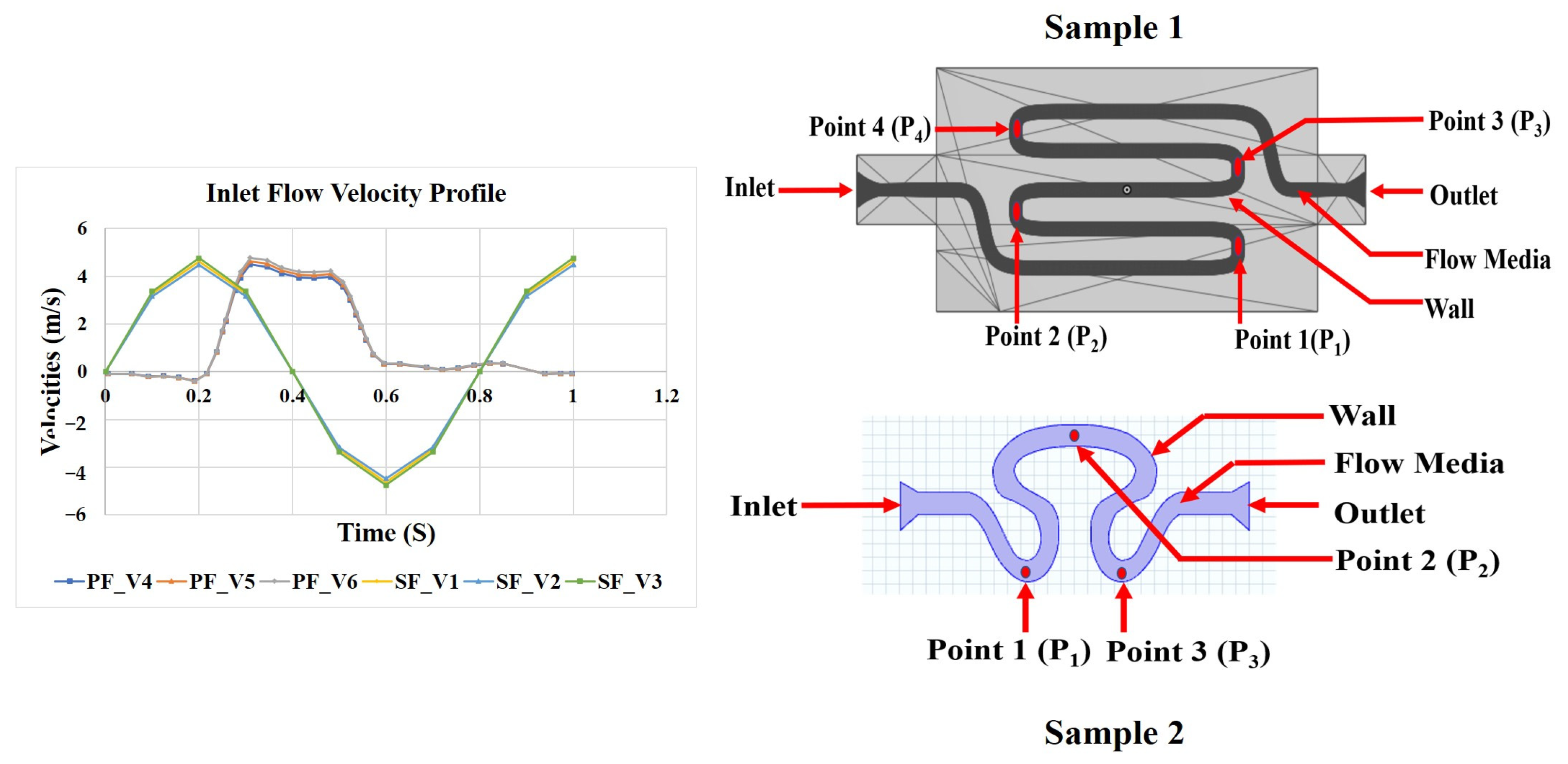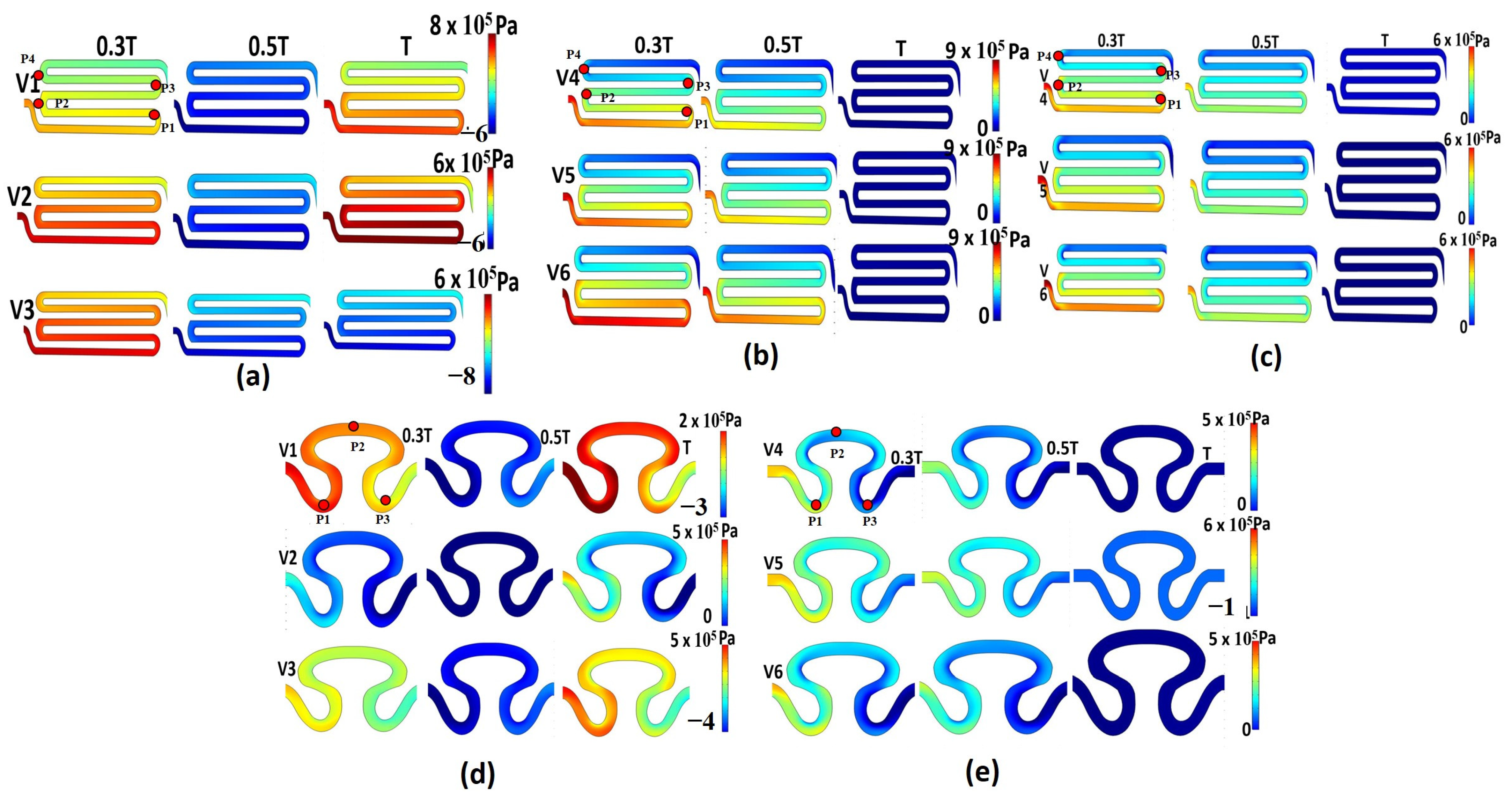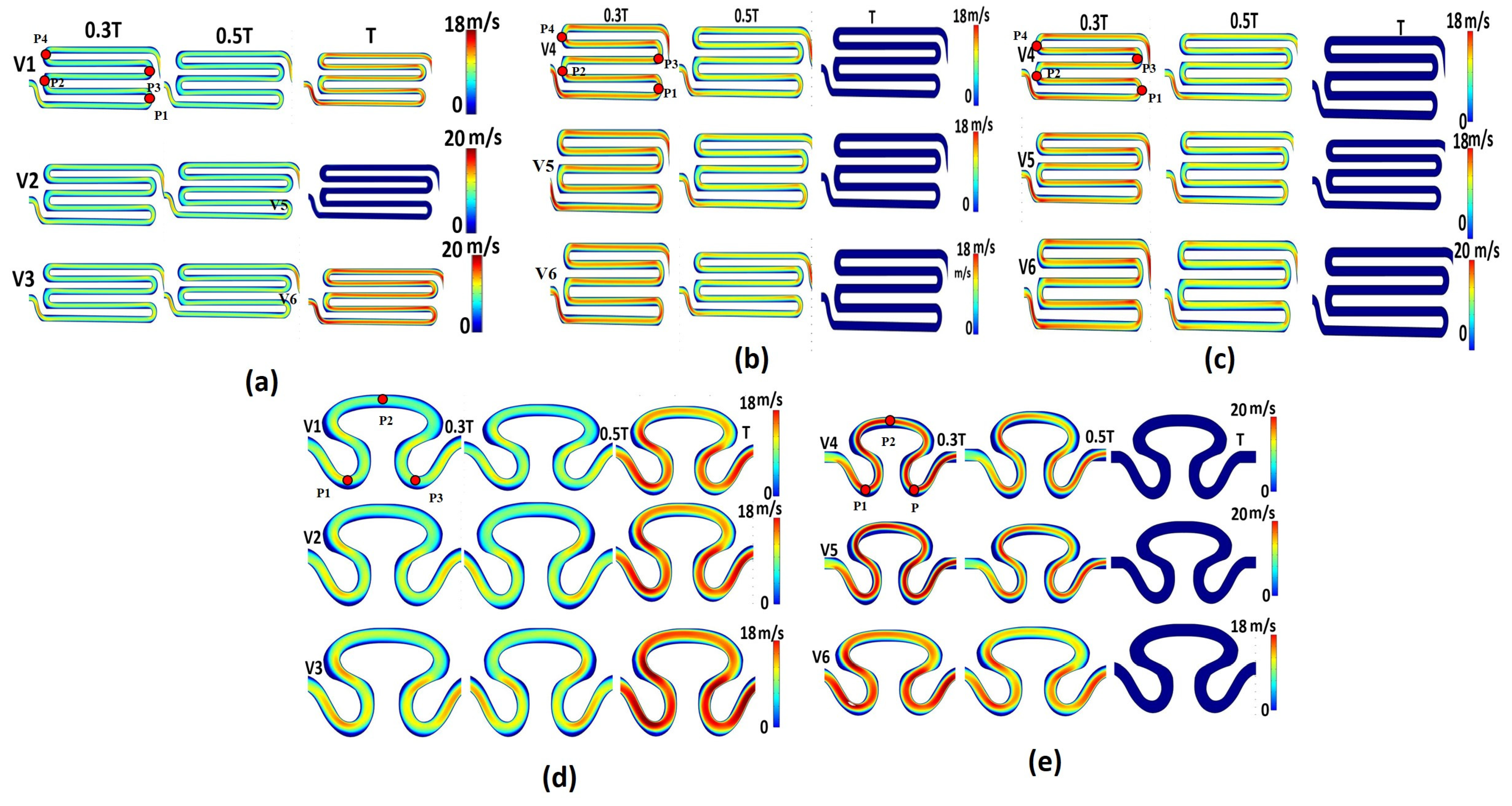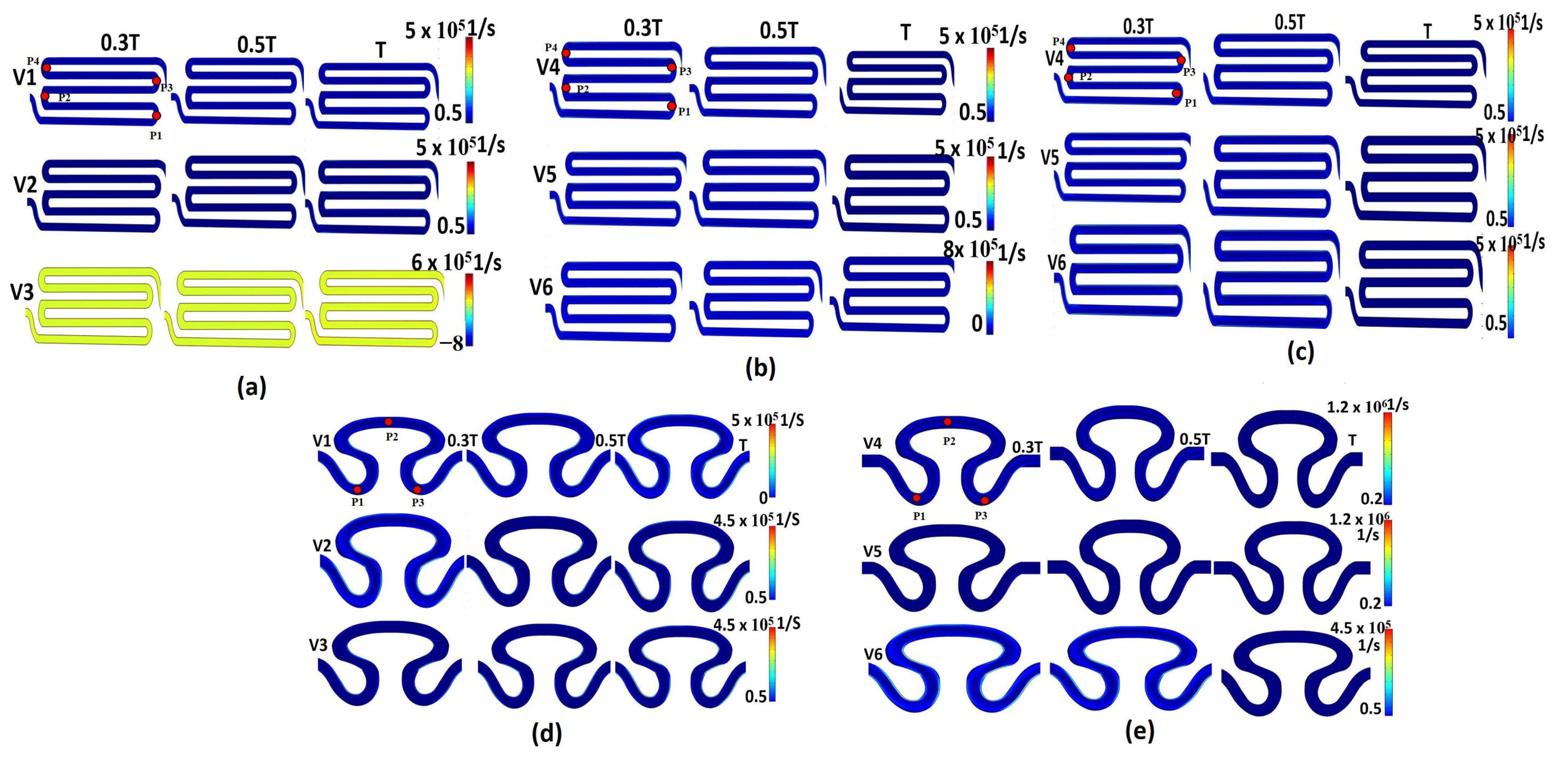Influence of Non-Newtonian Viscosity on Flow Structures and Wall Deformation in Compliant Serpentine Microchannels: A Numerical Study
Abstract
:1. Introduction
2. Methodology
2.1. Numerical Analysis
2.2. Grid Convergence Index
3. Results
4. Discussion
5. Conclusions
Author Contributions
Funding
Conflicts of Interest
References
- Kittler, H.; Riedl, E.; Rosendahl CAnd Cameron, A. Dermatoscopy of unpigmented lesions of the skin: A new classification of vessel morphology based on pattern analysis. Dermatopathol. Pract. Concept. 2008, 14, 3. [Google Scholar]
- Tomasina, C.; Bodet, T.; Mota, C.; Moroni, L.; Camarero-Espinosa, S. Bioprinting vasculature: Materials, cells and emergent techniques. Materials 2019, 12, 2701. [Google Scholar] [CrossRef] [PubMed]
- Camasão, D.B.; Mantovani, D.J.M.T.B. The mechanical characterization of blood vessels and their substitutes in the continuous quest for physiological-relevant performances. A critical review. Mater. Today Bio 2021, 10, 100106. [Google Scholar] [CrossRef] [PubMed]
- Bit, A.; Alblawi, A.; Chattopadhyay, H.; Quais, Q.A.; Benim, A.C.; Rahimi-Gorji, M.; Do, H.T. Three dimensional numerical analysis of hemodynamic of stenosed artery considering realistic outlet boundary conditions. Comput. Methods Programs Biomed. 2020, 185, 105163. [Google Scholar] [CrossRef]
- Wang, D.; Xu, Y.; Li, Q.; Turng, L.S. Artificial small-diameter blood vessels: Materials, fabrication, surface modification, mechanical properties, and bioactive functionalities. J. Mater. Chem. B 2020, 8, 1801–1822. [Google Scholar] [CrossRef]
- Bertassoni, L.E.; Cecconi, M.; Manoharan, V.; Nikkhah, M.; Hjortnaes, J.; Cristino, A.L.; Barabaschi, G.; Demarchi, D.; Dokmeci, M.R.; Yang, Y.; et al. Hydrogel bioprinted microchannel networks for vascularization of tissue engineering constructs. Lab Chip 2014, 14, 2202–2211. [Google Scholar] [CrossRef] [PubMed]
- Nie, J.; Gao, Q.; Wang, Y.; Zeng, J.; Zhao, H.; Sun, Y.; Shen, J.; Ramezani, H.; Fu, Z.; Liu, Z.; et al. Vessel-on-a-chip with hydrogel-based microfluidics. Small 2018, 14, 1802368. [Google Scholar] [CrossRef]
- Zhao, H.; Liu, M.; Zhang, Y.; Yin, J.; Pei, R. Nanocomposite hydrogels for tissue engineering applications. Nanoscale 2020, 12, 14976–14995. [Google Scholar] [CrossRef]
- Shukla, P.; Mitruka, M.; Pati, F. The effect of the synthetic route on the biophysiochemical properties of methacrylated gelatin (GelMA) based hydrogel for development of GelMA-based bioinks for 3D bioprinting applications. Materialia 2022, 25, 101542. [Google Scholar] [CrossRef]
- Ahmed, E.M. Hydrogel: Preparation, characterization, and applications: A review. J. Adv. Res. 2015, 6, 105–121. [Google Scholar] [CrossRef]
- Sun, W.; Gregory, D.A.; Tomeh, M.A.; Zhao, X. Silk fibroin as a functional biomaterial for tissue engineering. Int. J. Mol. Sci. 2021, 22, 1499. [Google Scholar] [CrossRef] [PubMed]
- Miah, M.; Karim, A. Computational Investigation of Pulsatile Blood Flow in the Models of Arterial Stenosis and Aneurysm. Ph.D. Dissertation, Department of Mechanical and Production Engineering (MPE), Islamic University of Technology (IUT), Gazipur, Bangladesh, 2018. [Google Scholar]
- Tiwari, A.; Chauhan, S.S. Effect of varying viscosity on two-layer model of pulsatile flow through blood vessels with porous region near walls. Transp. Porous Media 2019, 129, 721–741. [Google Scholar] [CrossRef]
- Dincau, B.; Dressaire, E.; Sauret, A. Pulsatile flow in microfluidic systems. Small 2020, 16, 1904032. [Google Scholar] [CrossRef] [PubMed]
- Zamir, M.; Budwig, R.S. Physics of pulsatile flow. Appl. Mech. Rev. 2002, 55, B35. [Google Scholar] [CrossRef]
- Hsiai, T.K.; Cho, S.K.; Honda, H.M.; Hama, S.; Navab, M.; Demer, L.L.; Ho, C.M. Endothelial cell dynamics under pulsating flows: Significance of high versus low shear stress slew rates (∂ τ/∂ τ). Ann. Biomed. Eng. 2002, 30, 646–656. [Google Scholar] [CrossRef] [PubMed]
- Lee, K.W.; Kim, D.H.; Lee, J.H.; Youn, Y.N. The effect of pulsatile flow on bmsc-derived endothelial-like cells in a small-sized artificial vessel made by 3-dimensional bioprinting. Stem Cells Int. 2018, 2018, 7823830. [Google Scholar] [CrossRef] [PubMed]
- Hendriks, M.; Ramasamy, S.K. Blood vessels and vascular niches in bone development and physiological remodeling. Front. Cell Dev. Biol. 2020, 8, 602278. [Google Scholar] [CrossRef]
- Dessalles, C.A.; Leclech, C.; Castagnino, A.; Barakat, A.I. Integration of substrate-and flow-derived stresses in endothelial cell mechanobiology. Commun. Biol. 2021, 4, 764. [Google Scholar] [CrossRef]
- Buchanan, C.F.; Verbridge, S.S.; Vlachos, P.P.; Rylander, M.N. Flow shear stress regulates endothelial barrier function and expression of angiogenic factors in a 3D microfluidic tumor vascular model. Cell Adhes. Migr. 2014, 8, 517–524. [Google Scholar] [CrossRef]
- Souilhol, C.; Serbanovic-Canic, J.; Fragiadaki, M.; Chico, T.J.; Ridger, V.; Roddie HAnd Evans, P.C. Endothelial responses to shear stress in atherosclerosis: A novel role for developmental genes. Nat. Rev. Cardiol. 2020, 17, 52–63. [Google Scholar] [CrossRef]
- Tokas, S. Performance Analysis of Simple-t and 3dhelical Passive Micromixers with Newtonian and Non-Newtonian Fluid. Ph.D. Dissertation, Delhi Technological University, Delhi, India, 2020. [Google Scholar]
- Lee, E.; Kim BAnd Choi, S. Hand-held, automatic capillary viscometer for analysis of Newtonian and non-Newtonian fluids. Sens. Actuators A Phys. 2020, 313, 112176. [Google Scholar] [CrossRef]
- Chauhan, S.S.; Tiwari, A. Solute dispersion in non-Newtonian fluids flow through small blood vessels: A varying viscosity approach. Eur. J. Mech.-B/Fluids 2022, 94, 200–211. [Google Scholar] [CrossRef]
- Mehri, R.; Mavriplis, C.; Fenech, M. Red blood cell aggregates and their effect on non-Newtonian blood viscosity at low hematocrit in a two-fluid low shear rate microfluidic system. PLoS ONE 2018, 13, e0199911. [Google Scholar] [CrossRef]
- Cho, Y.I.; Kensey, K.R. Effects of the non-Newtonian viscosity of blood on flows in a diseased arterial vessel. Part 1: Steady flows. Biorheology 1991, 28, 241–262. [Google Scholar] [CrossRef] [PubMed]
- Leone, M.; Asfar, P.; Radermacher, P.; Vincent, J.L.; Martin, C. Optimizing mean arterial pressure in septic shock: A critical reappraisal of the literature. Crit. Care 2015, 19, 101. [Google Scholar] [CrossRef] [PubMed]
- Kim, H.; Han, S.H.; Kook, Y.M.; Lee, K.M.; Jin, Y.Z.; Koh, W.G.; Lee, J.H.; Lee, K. A novel 3D indirect co-culture system based on a collagen hydrogel scaffold for enhancing the osteogenesis of stem cells. J. Mater. Chem. B 2020, 8, 9481–9491. [Google Scholar] [CrossRef] [PubMed]
- Demers, D.; Wachs, D. Physiology, mean arterial pressure. In Statpearls [Internet]; Statpearls Publishing: St. Petersburg, FL, USA, 2019. [Google Scholar]
- Papaioannou, T.G.; Protogerou, A.D.; Vrachatis, D.; Konstantonis, G.; Aissopou, E.; Argyris, A.; Nasothimiou, E.; Gialafos, E.J.; Karamanou, M.; Tousoulis, D.; et al. Mean arterial pressure values calculated using seven different methods and their associations with target organ deterioration in a single-center study of 1878 individuals. Hypertens. Res. 2016, 39, 640–647. [Google Scholar] [CrossRef] [PubMed]
- Deshmukh, K.; Gupta, S.; Mitra, K.; Bit, A. Numerical and Experimental Analysis of Shear Stress Influence on Cellular Viability in Serpentine Vascular Channels. Micromachines 2022, 13, 1766. [Google Scholar] [CrossRef]
- Guo, B.; Guo, C. The convergence of non-Newtonian fluids to Navier–Stokes equations. J. Math. Anal. Appl. 2009, 357, 468–478. [Google Scholar] [CrossRef]
- Gangawane, K.M.; Manikandan, B. Laminar natural convection characteristics in an enclosure with heated hexagonal block for non-Newtonian power law fluids. Chin. J. Chem. Eng. 2017, 25, 555–571. [Google Scholar] [CrossRef]
- Dejam, M. Dispersion in non-Newtonian fluid flows in a conduit with porous walls. Chem. Eng. Sci. 2018, 189, 296–310. [Google Scholar] [CrossRef]
- Basavaraja, P.; Surendran, A.; Gupta, A.; Saba, L.; Laird, J.R.; Nicolaides, A.; Mtui, E.E.; Baradaran, H.; Lavra, F.; Suri, J.S. Wall shear stress and oscillatory shear index distribution in carotid artery with varying degree of stenosis: A hemodynamic study. J. Mech. Med. Biol. 2017, 17, 1750037. [Google Scholar] [CrossRef]
- Sotelo Parraguez, J.A.; Urbina, J.; Valverde, I.; Tejos Nunez, C.A.; Irarrázaval Mena, P.; Andia Kohnenkampf, M.E.; Uribe Arancibia, S.A.; Hurtado Sepulveda, D.E. 3D Quantification of Wall Shear Stress and Oscillatory Shear Index Using a Finite-Element Method in 3D CINE PC-MRI Data of the Thoracic Aorta. IEEE Trans. Med. Imaging 2016, 35, 1475–1487. [Google Scholar] [CrossRef]
- Soulis, J.V.; Lampri, O.P.; Fytanidis, D.K.; Giannoglou, G.D. Relative residence time and oscillatory shear index of non-Newtonian flow models in aorta. In Proceedings of the 2011 10th International Workshop on Biomedical Engineering, Kos, Greece, 5–7 October 2011; pp. 1–4. [Google Scholar]
- Mutlu, O.; Salman, H.E.; Al-Thani, H.; El-Menyar, A.; Qidwai, U.A.; Yalcin, H.C. How does hemodynamics affect rupture tissue mechanics in abdominal aortic aneurysm: Focus on wall shear stress derived parameters, time-averaged wall shear stress, oscillatory shear index, endothelial cell activation potential, and relative residence time. Comput. Biol. Med. 2023, 154, 106609. [Google Scholar] [CrossRef] [PubMed]
- Braga da Costa Campos, L.M. Steady Heat Conduction. Complex Anal. Appl. Flows Fields 2020, 388, 607–634. [Google Scholar] [CrossRef]
- Sterling, T.; Brodowicz, M.; Anderson, M. High Performance Computing: Modern Systems and Practices; Morgan Kaufmann: Burlington, MA, USA, 2017. [Google Scholar]
- Amestoy, P.; Buttari, A.; Duff, I.; Guermouche, A.; L’Excellent, J.Y.; Uçar, B. Encyclopedia of Parallel Computing; Springer: Berlin/Heidelberg, Germany, 2011; pp. 1–15. [Google Scholar] [CrossRef]
- Bit, A.; Chattopadhyay, H. Numerical investigations of pulsatile flow in stenosed artery. Acta Bioeng. Biomech. 2014, 16, 33–44. [Google Scholar] [PubMed]
- Hoque, M.M.; Alam, M.M. Effects of Dean number and curvature on fluid flow through a curved pipe with magnetic field. Procedia Eng. 2013, 56, 245–253. [Google Scholar] [CrossRef]
- Wang, X.; Liu, Z.; Cai, Y.; Wang, B.; Luo, X. A cost-effective serpentine micromixer utilizing ellipse curve. Anal. Chim. Acta 2021, 1155, 338355. [Google Scholar] [CrossRef]
- Shen, F.; Ai, M.; Ma, J.; Li, Z.; Xue, S. An easy method for pressure measurement in microchannels using trapped air compression in a one-end-sealed capillary. Micromachines 2020, 11, 914. [Google Scholar] [CrossRef]
- Zhang, H.; Liu, X. Numerical analysis of the flow and heat transfer characteristics in serpentine microchannel with variable bend amplitude. Int. J. Numer. Methods Heat Fluid Flow 2021, 31, 2022–2041. [Google Scholar] [CrossRef]
- Andersson, M. Microfluidics at High Pressures: Understanding, Sensing, and Control. Ph.D. Dissertation, Acta Universitatis Upsaliensis, Uppsala, Sweden, 2018. [Google Scholar]
- Hazar, H.; Yilmaz, M.; Sevinc, H. A comparative analysis of a novel flow field pattern with different channel size configurations. Fuel 2022, 319, 123867. [Google Scholar] [CrossRef]
- Jha, B.K.; Malgwi, P.B. Computational analysis on unsteady hydromagnetic Couette flow of fluid—Particle suspension in an accelerated porous channel. Partial. Differ. Equ. Appl. Math. 2022, 5, 100370. [Google Scholar] [CrossRef]
- Rahmati, A.R.; Akbari, O.A.; Marzban, A.; Toghraie, D.; Karimi, R.; Pourfattah, F. Simultaneous investigations the effects of non-Newtonian nanofluid flow in different volume fractions of solid nanoparticles with slip and no-slip boundary conditions. Therm. Sci. Eng. Prog. 2018, 5, 263–277. [Google Scholar] [CrossRef]
- Qin, R.; Duan, C. The principle and applications of Bernoulli equation. J. Phys. Conf. Ser. 2017, 916, 012038. [Google Scholar] [CrossRef]
- Quetzeri-Santiago, M.A.; Hunter, I.W.; van der Meer, D.; Rivas, D.F. Impact of a microfluidic jet onto a pendant droplet. arXiv 2021, arXiv:2105.12361. [Google Scholar]
- Benoit, C. Re: Why is the Shear Stress Maximum at the Walls of a Microfluidic Device? Available online: https://www.researchgate.net/post/Why-is-the-shear-stress-maximum-at-the-walls-of-a-microfluidic-device/59f6fe9d404854506c67f2a3/citation/download (accessed on 22 August 2023).
- Sun, P.; Zhou, L.; Wang, Z.; Shi, J. Influences of geometric parameters on serpentine nozzles for turbofan. Aerosp. Sci. Technol. 2023, 136, 108224. [Google Scholar] [CrossRef]
- Abed, W.M.; Whalley, R.D.; Dennis, D.J.; Poole, R.J. Experimental investigation of the impact of elastic turbulence on heat transfer in a serpentine channel. J. Non-Newton. Fluid Mech. 2016, 231, 68–78. [Google Scholar] [CrossRef]
- Dutta, P.; Nandi, N. Effect of bend curvature on velocity & pressure distribution from straight to a 90° pipe bend-A Numerical Study. REST J. Emerg. Trends Model. Manuf. 2016, 2, 103–108. Available online: www.restpublisher.com/journals/jemm (accessed on 22 August 2023).
- Ionescu, V. Numerical modeling of centrifugal microfluidic flow in rectangular channels for Lab-on-a-CD platform applications. In Advanced Topics in Optoelectronics, Microelectronics and Nanotechnologies X (Vol. 11718, 289-299); SPIE: Washington, DC, USA, 2020. [Google Scholar]
- Amaratunga, M.; Rabenjafimanantsoa, H.A.; Time, R.W. Estimation of shear rate change in vertically oscillating non-Newtonian fluids: Predictions on particle settling. J. Non-Newton. Fluid Mech. 2020, 277, 104236. [Google Scholar] [CrossRef]
- Yang, H.; Yao, G.; Wen, D. Experimental investigation on convective heat transfer of Shear-thinning fluids by elastic turbulence in a serpentine channel. Exp. Therm. Fluid Sci. 2020, 112, 109997. [Google Scholar] [CrossRef]
- Hamedi, N.; Revstedt, J.; Tornberg, E.; Innings, F. Application of CFD-based correction factors to increase the accuracy of flow curve determination in a couette rheometer. Appl. Rheol. 2016, 26, 35341. [Google Scholar] [CrossRef]
- Ducloué, L.; Casanellas, L.; Haward, S.J.; Poole, R.J.; Alves, M.A.; Lerouge, S.; Shen, A.Q.; Lindner, A. Secondary flows of viscoelastic fluids in serpentine microchannels. Microfluid. Nanofluidics 2019, 23, 33. [Google Scholar] [CrossRef]
- Poole, R.J.; Lindner, A.; Alves, M.A. Viscoelastic secondary flows in serpentine channels. J. Non-Newton. Fluid Mech. 2013, 201, 10–16. [Google Scholar] [CrossRef]
- Del Giudice, F. A review of microfluidic devices for rheological characterisation. Micromachines 2022, 13, 167. [Google Scholar] [CrossRef]
- Thurgood, P.; Suarez, S.A.; Pirogova, E.; Jex, A.R.; Peter, K.; Baratchi, S.; Khoshmanesh, K. Tunable harmonic flow patterns in microfluidic systems through simple tube oscillation. Small 2020, 16, 2003612. [Google Scholar] [CrossRef] [PubMed]
- Fan, Z.; Liu, X.; Zhang, Y.; Zhang, N.; Ye, X.; Deng, X. Hemodynamic impact of stenting on carotid bifurcation: A potential role of the stented segment and external carotid artery. Comput. Math. Methods Med. 2021, 2021, 7604532. [Google Scholar] [CrossRef]
- Pietrasanta, L.; Mameli, M.; Mangini, D.; Georgoulas, A.; Michè, N.; Filippeschi, S.; Marengo, M. Developing flow pattern maps for accelerated two-phase capillary flows. Exp. Therm. Fluid Sci. 2020, 112, 109981. [Google Scholar] [CrossRef]







| Inlet Velocity | Model | Parameters Value | Function |
|---|---|---|---|
| Sinusoidal flow (SF) | V1 | f = 1.25 Hz, t = 0 to 1 s | V1(t) = |
| V2 | V2(t) = | ||
| V3 | V3(t) = | ||
Physiological flow (PF) | V4 | t = 0 to 1 s, a1 = 3.04, b1 = 0.8634, c1 = −0.07247, a2 = 1.24, b2 = 14.02, c2 = 2.164, a3 = 2.619, b3 = 5.81, c3 = −0.5393, a4 = 0.4497, b4 = 24.25, c4 = 1.474, a5 = 0.3847, b5 = 32.5, c5 = −2.181, a6 = 0.4739, b6 = 20.77, c6 = 0.4904, a7 = 0.2708, b7 = 37.65, c7 = 2.495, a8 = 0.1386, b8 = 52.47, c8 = −0.7126 | V4 (t) = |
| V5 | t = 0 to 1 s, a1 = 2.721, b1 = 1.588, c1 = −0.4734, a2 = 1.364, b2 = 13.48, c2 = 2.332, a3 = 3.081, b3 = 5.052, c3 = −0.1051, a4 = 0.3837, b4 = 24.37, c4 = 1.263, a5 = 0.4042, b5 = 32.44, c5 = −2.133, a6 = 0.4619, b6 = 19.567, c6 = 0.9404, a7 = 0.2744, b7 = 37.67, c7 = 2.482, a8 = 0.1435, b8 = 52.48, c8 = −0.7228 | V5 (t) = | |
| V6 | t = 0 to 1 s, a1 = 2.864, b1 = 1.405, c1 = −0.3165, a2 = 1.322, b2 = 13.96, c2 = 2.122, a3 = 3.008, b3 = 5.506, c3 = −0.3209, a4 = 0.7938, b4 = 22.63, c4 = 2.259, a5 = 0.4209, b5 = 31.95, c5 = −1.982, a6 = 0.8909, b6 = 20.65, c6 = 0.3462, a7 = 0.3141, b7 = 37.4, c7 = 2.577, a8 = 0.1474, b8 = 52.51, c8 = −0.7326 | V6 (t) = |
| Model | Serpentine Model | Viscosity Formation | Inlet Boundary Condition | Inlet Velocity Conditions |
|---|---|---|---|---|
| I | S1 | Non-Newtonian (NN) | Sinusoidal flow (SF) | V1 |
| V2 | ||||
| V3 | ||||
| II | Non-Newtonian (NN) | Physiological flow (PF) | V4 | |
| V5 | ||||
| V6 | ||||
| III | Newtonian (N) | Physiological flow (PF) | V4 | |
| V5 | ||||
| V6 | ||||
| IV | S2 | Non-Newtonian (NN) | Sinusoidal flow (SF) | V1 |
| V2 | ||||
| V3 | ||||
| V | Non-Newtonian (NN) | Physiological flow (PF) | V4 | |
| V5 | ||||
| V6 |
| Variable | Model and Point | r | p | Fs | (%) | (%) |
|---|---|---|---|---|---|---|
| Pressure | S1, P1 | 1.793 | 0.794 | 1.25 | 4.4 | 2.7 |
| S2, P1 | 1.795 | 0.623 | 3.2 | 4 |
| S.No. | Models | Parameter | Point | Time | Deviation | |
|---|---|---|---|---|---|---|
| 1 | S1_NN_NS_SF_V1, V2, V3 | Pressure | P1 (V3) percent [V2, V3] | 0.3 | Minimum | 2.57 |
| P3 (V3) percent [V3, V1] | 1 | Maximum | 37.86 | |||
| Shear rate | P4 (V1) percent [V1, V2] | 0.5 | Minimum | 0.26 | ||
| P4 (V2) percent [V2, V3] | 1 | Maximum | 67.36 | |||
| Velocity | P4 (V2) percent [V1, V2] | 0.5 | Minimum | 2.33 | ||
| P3 (V3) percent [V3, V1] | 0.3 | Maximum | 10.18 | |||
| 2 | S1_NN_NS_PF_V4, V5, V6 | Pressure | P1 (V5) percent [V4, V5] | 1 | Minimum | 1.94 |
| P3 (V6) percent [V4, V6] | 0.3 | Maximum | 37.46 | |||
| Velocity | P1 (V5) percent [V4, V5] | 0.5 | Minimum | 2.77 | ||
| P3 (V6) percent [V4, V6] | 0.3 | Maximum | 7.65 | |||
| 3 | S1_N_NS_PF_V4, V5, V6 | Pressure | P2 (V6) percent [V4, V5] | 1 | Minimum | 3.02 |
| P3 (V6) percent [V6, V4] | 0.3 | Maximum | 37.46 | |||
| Velocity | P1 (V6) percent [V5, V6] | 1 | Minimum | 2.64 | ||
| P3 (V6) percent [V6, V5] | 1 | Maximum | 15.15 | |||
| 4 | S2_NN_NS_SF_V1, V2, V3 | Pressure | p1 (V3) percent [V2, V3] | 0.5 | Minimum | 3.33 |
| p1 (V1) percent [V3, V1] | 1 | Maximum | 10.42 | |||
| Shear rate | p1 (V2) percent [V2, V1] | 1 | Minimum | 2.10 | ||
| p2 (V1) percent [V1, V3] | 0.3 | Maximum | 13.55 | |||
| Velocity | p3 (V2) percent [V3, V1] | 0.5 | Minimum | 2.91 | ||
| p3 (V3) percent [V1, V3] | 1 | Maximum | 5.86 | |||
| 5 | S2_NN_NS_PF_V4, V5, V6 | Pressure | P2(V6) percent [V5, V6] | 1 | Minimum | 0.009 |
| P1 (V4) percent [V6, V4] | 1 | Maximum | 39.98 | |||
| Shear rate | P1(V5) percent [V5, V6] | 1 | Minimum | 0.28 | ||
| P2 (V6) percent [V5, V6] | 0.5 | Maximum | 70.15 | |||
| Velocity | P3 (V6) percent [V5, V6] | 0.5 | Minimum | 0.140 | ||
| P2(V6) percent [V5, V6] | 0.5 | Maximum | 25.8 | |||
Disclaimer/Publisher’s Note: The statements, opinions and data contained in all publications are solely those of the individual author(s) and contributor(s) and not of MDPI and/or the editor(s). MDPI and/or the editor(s) disclaim responsibility for any injury to people or property resulting from any ideas, methods, instructions or products referred to in the content. |
© 2023 by the authors. Licensee MDPI, Basel, Switzerland. This article is an open access article distributed under the terms and conditions of the Creative Commons Attribution (CC BY) license (https://creativecommons.org/licenses/by/4.0/).
Share and Cite
Deshmukh, K.; Mitra, K.; Bit, A. Influence of Non-Newtonian Viscosity on Flow Structures and Wall Deformation in Compliant Serpentine Microchannels: A Numerical Study. Micromachines 2023, 14, 1661. https://doi.org/10.3390/mi14091661
Deshmukh K, Mitra K, Bit A. Influence of Non-Newtonian Viscosity on Flow Structures and Wall Deformation in Compliant Serpentine Microchannels: A Numerical Study. Micromachines. 2023; 14(9):1661. https://doi.org/10.3390/mi14091661
Chicago/Turabian StyleDeshmukh, Khemraj, Kunal Mitra, and Arindam Bit. 2023. "Influence of Non-Newtonian Viscosity on Flow Structures and Wall Deformation in Compliant Serpentine Microchannels: A Numerical Study" Micromachines 14, no. 9: 1661. https://doi.org/10.3390/mi14091661
APA StyleDeshmukh, K., Mitra, K., & Bit, A. (2023). Influence of Non-Newtonian Viscosity on Flow Structures and Wall Deformation in Compliant Serpentine Microchannels: A Numerical Study. Micromachines, 14(9), 1661. https://doi.org/10.3390/mi14091661









